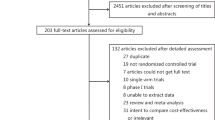Summary
Lenograstim is a recombinant colony-stimulating factor that has been shown to be a useful adjunctive agent in cancer chemotherapy. Clinical trials have demonstrated the efficacy of lenograstim in correcting chemotherapy-induced neutropenia and associated complications in inflammatory breast cancer and non-Hodgkin’s lymphoma, and in facilitating dose intensification of chemotherapy in small cell lung cancer.
To meet increasing demands for economic data on new drug entities, a lenograstim pharmacoeconomics programme was established. This programme involved prospective economic evaluations of lenograstim that were undertaken as part of phase III randomised clinical trials by a combined German/Italian health-economics team (inflammatory breast cancer), a French team (non-Hodgkin’s lymphoma), and a team from the UK (small cell lung cancer).
Similar content being viewed by others
References
Bodey GP, Buckley M, Sathe YS, et al. Quantitative relationship between circulating leukocytes and infection in patients with acute leukemia. Ann Intern Med 1966; 64: 328–40
Infectious Diseases Society of America: guidelines for the use of antimicrobial agents in neutropenic patients with antimicrobial agents in neutropenic patients with unexplained fever. J Infect Dis 1990; 161: 381–96
Leischke GJ, Burgess AW. Granulocyte colony-stimulating factor and macrophage colony-stimulating factor. N Engl J Med 1992; 327: 28–35 (first of 2 parts); 327: 99–105 (second of 2 parts)
Pizzo, PA. After empiric therapy: what to do until the granulocyte comes back. Rev Infect Dis 1987; 9: 214–9
Groopman JE, Molina JM, Scadden DT. Hematopoietic growth factors. Biology and clinical applications. N Engl J Med 1989; 321: 1449–59
Cronkite EP. Analytic review of structure and regulation of hemopoiesis. Blood Cells 1988; 14: 313–28
Nathan EP. Introduction of hematologic diseases. In: Wymgaarden JB, Smith LH, Claude Bennett J, editors. Cecil textbook of medicine. 19th ed. Philadelphia: W.B. Saunders Co., 1992: 817–22
Yoshino T, Tamura M, Hattori K, et al. Effects of recombinant human granulocyte colony-stimulating factor on neutrophil function in normal rats. Int J Hematol 1991; 54: 455–62
Matsumoto M, Matsubara S, Yokota T. Effect of combination therapy with recombinant human granulocyte colony-stimulating factor (rG-CSF) and antibiotics in neutropenic mice unresponsive to antibiotics alone. J Antimicrob Chemother 1991; 28(3): 447–53
Metcalf D. Colony stimulating factors: discovery, development and clinical applications. Cancer 1990; 65: 2185–95
Kubota N, Orita T, Hattori K, et al. Structural characterization of natural and recombinant human granulocyte colony stimulating factors. J Biochem 1990; 107: 486–92
Oh-eda M, Hasegawa M, Hattori K, et al. O-Linked sugar chain of human granulocyte colony stimulating factor protects it against polymerization and denaturation allowing it to retain its biological activity. J Biol Chem 1990; 265: 11432–5
Kishita M, Motojima H, Oh-eda M, et al. Stability of granulocyte colony-stimulating factor (G-CSF) in serum. Clin Rep 1992; 26: 221
World Health Organization (WHO) BS/92.1711. International collaborative study for the proposed international standards for granulocyte macrophage-colony stimulating factor and granulocyte-colony stimulating factor, 1994
Nissen C, Carbonare VD, Moser Y. Invitrocomparison of the biological potency of glycosylated versus nonglycosylated rHuG-CSF. Drug Invest 1994; 7: 346–52
Stoppa AM, Blaise D, Viens P, et al. Phase I study of invivo lenograstim (rHuG-CSF) for stem cell collection demonstrates improved neutrophil recovery after autologous bone marrow transplantation. Bone Marrow Transplant 1994; 13: 541–7
Linch DC, Scarffe H, Proctor S, et al. Randomised vehicle-controlled dose-finding study of glycosylated recombinant human granulocyte colony-stimulating factor after bone marrow transplantation. Bone Marrow Transplant 1993; 11: 307–11
Chevallier B, Chollet P, Merrouche Y, et al. Glycosylated rHuG-CSF (lenograstim) prevents morbidity from FEC-HD chemotherapy in inflammatory breast cancer (IBC). Proc Am Soc Clin Oncol 1993; 12: 137
Gisselbrecht C, Lepage E, Haioun C, et al. Lenograstim (glycosylated recombinant human G-CSF) supported chemotherapy optimisation in aggressive nonHodgkin’s lymphoma (NHL). Proc Am Soc Clin Oncol 1993; 12: 363
Gisselbrecht C, Prentice HG, Bacigalupo A, et al. Placebo-controlled phase III trial of lenograstim in bone-marrow transplantation. Lancet 1994; 343: 696–700
Drummond MF, Rutten FFH, Brenna A, et al. Economic evaluation of pharmaceuticals: a European perspective. PharmacoEconomics 1993; 4: 173–86
Woll PJ, Hodgketts H, Lomax L, et al. Use of rHuG-CSF (lenograstim) to dose intensify in small-cell lung cancer (SCLC): a randomized study. Eur J Cancer 1993; 29A Suppl. 6: S154
Drummond M, Menzin J, Oster G. Methodological issues in economic assessments of new therapies: the case of colonystimulating factors. PharmacoEconomics 1994; 6 Suppl. 2: 18–26
Mapelli V, Schulenburg J-MG, Laaser U, et al. Economic evaluation of lenograstim (glycosylated rHuG-CSF) in the treatment of inflammatory breast cancer for Germany and Italy. PharmacoEconomics 1994; 6 Suppl. 2: 27–35
Souêtre E, Qing W. Economic analysis of lenograstim in the correction of neutropenia following chemotherapy for nonHodgkin’s lymphoma. PharmacoEconomics 1994; 6 Suppl. 2: 36–43
Drummond M, Davies L. Economic evaluation of lenograstim for prophylaxis of chemotherapy-induced neutropenia in patients with small cell lung cancer. PharmacoEconomics 1994; 6 Suppl. 2: 44–52
Menzin J, Oster G, Cour-Chabernaud V, et al. Pharmacoeconomic evaluation of lenograstim: conclusions and future directions. PharmacoEconomics 1994; 6 Suppl. 2: 53–60
Author information
Authors and Affiliations
Rights and permissions
About this article
Cite this article
Oster, G., Menzin, J., Richard, D. et al. Overview of the Lenograstim Pharmacoeconomics Programme. Pharmacoeconomics 6 (Suppl 2), 9–17 (1994). https://doi.org/10.2165/00019053-199400062-00004
Published:
Issue Date:
DOI: https://doi.org/10.2165/00019053-199400062-00004




